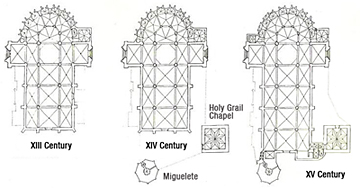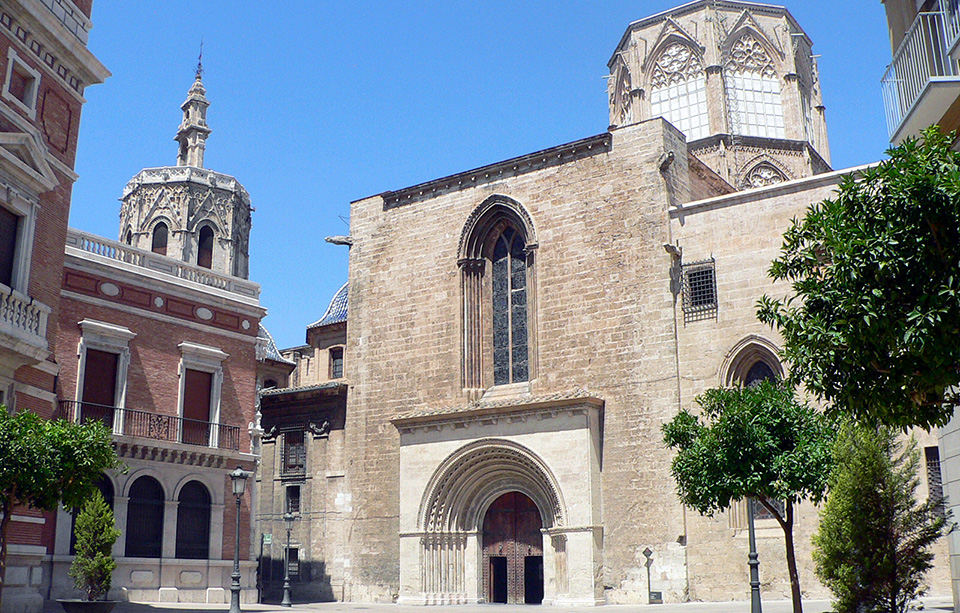The Cathedral of Valencia was consecrated in 1238. Gothic architecture is the predominant style, although it also contains Romanesque, Renaissance, Baroque and neoclassical elements.
The Cathedral of Valencia (Metropolitan Basilica Cathedral), commonly known as the "Seu", was consecrated in 1238 by the first bishop of Valencia Pere d'Albalat and was dedicated by order of James I the Conqueror to Saint Mary. It was built upon the mosque, which in turn had been raised in place of the former Visigothic cathedral. Gothic architecture is the predominant style of this cathedral, although it also contains Romanesque, Renaissance art, Baroque and neoclassical elements.
One of the supposed Holy Chalices, present around the world, is revered in one of this cathedral's chapels; this chalice has been defended as the true Holy Grail; indeed, most Christian historians all over the world declare that all their evidence points to this Valencian chalice as the most likely candidate for being the authentic cup used at the Last Supper. This chalice dates from the 1st century, and was given to the cathedral by king Alfons el Magnànim in 1436.
Furthermore, this cathedral contains examples of some of the earliest and best Quattrocento paintings of the Iberian Peninsula, which was brought from Rome via artists engaged by the Valencian Pope Alexander VI who, when still a cardinal, made the request to elevate the Valencian See to the rank of metropolitan see, a category granted by Pope Innocent VIII in 1492.

Tourist Attractions: Church
Century: XIII
Style: Gothic
Itinerary: El Mercat
Category: 
The Cathedral of Valencia: From Romanesque to Baroque.
The Cathedral of Valencia History
Most of Valencia Cathedral was built between the XIIIth century and the XVth, and that is why its style is mainly gothic. However, its construction went on for centuries. As a consequence there is a mixture of artistic styles, ranging from the early romanesque, the subtle renaissance, the heavy Baroque and the more restrained neoclassic. This mixture is the most important feature of Valencia cathedral and is what makes it a jewel of universal architecture.
Excavations in the adjacent Almoina Archaeological Centre have unearthed the remains of the ancient Visigoth cathedral, which later became a mosque. There is documentary evidence that some decades after the Christian conquest of the city (1238), the mosque-cathedral remained standing until the 22 June 1262, when Brother Andreu d'Albalat resolved to knock it down and build a new cathedral in its place, according to the plans of the architect Arnau Vidal.
Although there are several styles of construction, this cathedral is basically a gothic building, with three naves with a transept covered with an octagonal tower (cimbori), with an ambulatory and a polygonal apse. This cathedral began to be built at the end of the thirteenth century (1270-1300) at the same time as the mosque was being demolished. The first part to be finished was the eight-chapel ambulatory, and the Almoina romanesque gate.
Between 1300 and 1350 the transept was finished and its west side went up until the Apostles’ gothic Gate. Three out of the four sections of the naves (the main nave and two secondary naves on either side) were also built. The transept tower (cimbori or eight-sided dome) was also begun.
 The old Chapter House (today Holy Grail Chapel) (1356-1369), where the canons met to discuss internal affairs, and the Micalet (bellfry) (1381-1425) were initially separate from the rest of the church, but in 1459 the architects Francesc Baldomar and Pere Comte expanded the naves in a further section, known as Arcada Nova, and finally joined both the chapter house and the Micalet with the rest of the Cathedral, thereby attaining 94 metres in length and 53.65 metres in width.
The old Chapter House (today Holy Grail Chapel) (1356-1369), where the canons met to discuss internal affairs, and the Micalet (bellfry) (1381-1425) were initially separate from the rest of the church, but in 1459 the architects Francesc Baldomar and Pere Comte expanded the naves in a further section, known as Arcada Nova, and finally joined both the chapter house and the Micalet with the rest of the Cathedral, thereby attaining 94 metres in length and 53.65 metres in width.
Centuries of the Renaissance (XV-XVI) had little influence on the architecture of the Cathedral but much more on its pictorial decoration, such as the one at the high altar, and sculptural decoration, such as the one in the Resurrection chapel.
During the Baroque, the German Konrad Rudolf designed in 1703 the main door of the cathedral, known as the Iron gate due to the cast-iron fence that surrounds it. Because of the Spanish Succession War he could not finish it, and this task fell mainly to the sculptors Francisco Vergara and Ignacio Vergara. Its concave shape, which causes a unique and studied perspective effect, was distorted during the twentieth century because of the demolition of some adjacent buildings (in what was formerly Zaragoza street) to expand the square (plaza de la Reina).
A project to renew the building was launched during the last third of the eighteenth century, whose intention was to give a uniform neoclassical appearance to the church, different from the original gothic style, that was then considered a vulgar work in comparison. Works started in 1774, directed by the architect Antoni Gilabert Fornés. The reshuffle affected both constructive and ornamental elements: the pinnacles were removed outside, and the gothic structure masked by stucco and other pseudo-classical elements.
In 1931 the church was declared a historic and artistic landmark by the Spanish government, but during the Spanish Civil War it was burned, which meant that it lost part of its decorative elements. The chorus, located in the central part, was dismantled in 1940 and moved to the bottom of the high altar. The organs, which had suffered major damage during the war, were never rebuilt. Also in 1970, the Houses of Canons, a building attached to the chapels facing Miguelete street, were demolished to give the cathedral back its previous appearance, and at the same time elements of little or no architectural value were removed.
The task of removing the neoclassical elements in order to recover the original gothic aspect was undertaken in 1972. The only neoclassical elements spared were most of the ambulatory chapels, and some isolated elements, such as the sculptures at the base of the dome (cimbori).
Useful Information
OPENING HOURS
From 8:30 to 20:30 h.
Guided visits from 10:00 to 17:30 h. and Sundays from 14:00 to 17:30 h.
TICKETS
Fee: 3 Euros
For children from 7 to 12 years, groups, pensioners and students with Youth Card: 2.10 Euro.
Hotels near the Cathedral
We are offering some of the best hotels deals in Valencia so check out the Hotels section. All hotels are conveniently located near landmarks and have been carefully selected and brought to you at the best possible price!.
The Cathedral Map
Address:
Plaza de la Reina, Valencia 46003.
The Cathedral of Valencia Pictures





























































